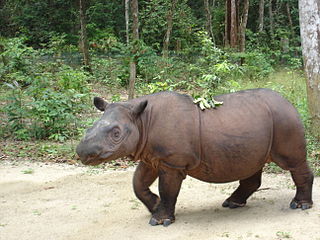
The Sumatran rhinoceros, also known as the Sumatran rhino, hairy rhinoceros or Asian two-horned rhinoceros, is a rare member of the family Rhinocerotidae and one of five extant species of rhinoceros; it is the only extant species of the genus Dicerorhinus. It is the smallest rhinoceros, although it is still a large mammal; it stands 112–145 cm (44–57 in) high at the shoulder, with a head-and-body length of 2.36–3.18 m and a tail of 35–70 cm (14–28 in). The weight is reported to range from 500–1,000 kg (1,100–2,200 lb), averaging 700–800 kg (1,540–1,760 lb). Like both African species, it has two horns; the larger is the nasal horn, typically 15–25 cm (5.9–9.8 in), while the other horn is typically a stub. A coat of reddish-brown hair covers most of the Sumatran rhino's body.

Dicerorhinus is a genus of the family Rhinocerotidae, consisting of a single extant species, the two-horned Sumatran rhinoceros, and several extinct species. The genus likely originated in the Mid to Late Pliocene of Northern Indochina and South China. Many species previously placed in this genus probably belong elsewhere.
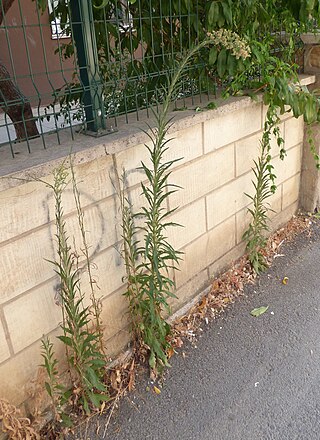
Erigeron sumatrensis is an annual herb probably native to South America, but widely naturalised in tropical and subtropical regions, and regarded as an invasive weed in many places.

The large bamboo rat, Sumatran rat, or Indomalayan rat is a species of rodent in the family Spalacidae found in Cambodia, China, Indonesia, Laos, Malaysia, Myanmar, Thailand, and Vietnam. It is one of four species of bamboo rat. Individuals can reach lengths of nearly 50 cm (20 in) with a 20 cm (7.9 in) tail, and weigh up to 4 kilograms (8.8 lb).
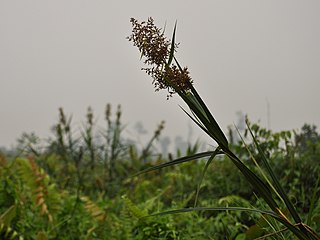
Scleria sumatrensis, commonly known as nutrush and Sumatran scleria, is a plant species in the sedge family. It is native to temperate and tropical Asia, where it is usually found growing in wetlands, and is considered a noxious weed on the island of Borneo. It has been used in traditional medicine against gonorrhea.

Filopaludina sumatrensis is a species of large freshwater snail with a gill and an operculum, an aquatic gastropod mollusc in the family Viviparidae.
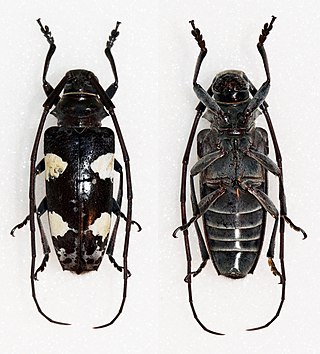
Blepephaeus is a genus of longhorn beetles of the subfamily Lamiinae, containing the following species:

The northern Sumatran rhinoceros, also known as Chittagong rhinoceros or northern hairy rhinoceros, was the most widespread subspecies of Sumatran rhinoceros, as well as the only known subspecies native to mainland Asia.
Blepephaeus andamanicus is a species of beetle in the family Cerambycidae. It was described by Stephan von Breuning in 1935. It is known from the Andaman Islands.
Blepephaeus indicus is a species of beetle in the family Cerambycidae. It was described by Stephan von Breuning in 1935. It is known from India.
Blepephaeus lemoulti is a species of beetle in the family Cerambycidae. It was described by Stephan von Breuning in 1938. It is known from Laos.
Blepephaeus strandi is a species of beetle in the family Cerambycidae. It was described by Stephan von Breuning in 1936.
Blepephaeus fulvus is a species of beetle in the family Cerambycidae. It was described by Maurice Pic in 1933. It is known from Malaysia, China, Vietnam, and Thailand.
Blepephaeus higaononi is a species of beetle in the family Cerambycidae. It was described by Vives in 2009. It is known from the Philippines.

Blepephaeus irregularis is a species of beetle in the family Cerambycidae. It was described by Heller in 1915. It is known from the Philippines. It contains the varietas Blepephaeus irregularis var. alboreductus.
Blepephaeus nepalensis is a species of beetle in the family Cerambycidae. It was described by Masao Hayashi in 1981. It is known from Nepal.
Blepephaeus puae is a species of beetle in the family Cerambycidae. It was described by Lin in 2011. It is known from China.
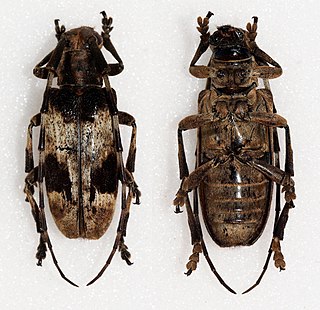
Blepephaeus succinctor is a species of beetle in the family Cerambycidae. It was described by Louis Alexandre Auguste Chevrolat in 1852, originally under the genus Monohammus. It is known from Malaysia, India, Sumatra, Myanmar, Taiwan, China, Thailand, and Vietnam. It feeds on Acacia confusa, Albizia chinensis, Firmiana simplex, Melia azedarach, Morus alba, and Vernicia fordii.
Blepephaeus undulatus is a species of beetle in the family Cerambycidae. It was described by Maurice Pic in 1930.










